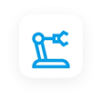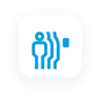Sensors form an integral part of today’s electronics, and more importantly, robotics. Thanks to advancements in sensor technology, we now have access to various sensors with different capabilities. However, selecting the right sensor for your robotic prototype can sometimes get challenging with more options to choose from.
For example, if your robotics application demands measuring proximity, you can choose between an inductive proximity sensor and a capacitive proximity sensor. There are several other proximity sensor options available that may offer better sensing capabilities for your application. As sensor manufacturers continue building new, robust and capable sensor products, finding the right sensor that best meets your prototyping requirements might get increasingly complex.
Here’s a handy guide to help you with sensor selection.
Start With the Objective
With a multitude of sensor options to choose from, it can get a bit overwhelming when you first delve into it, especially when you fear the outcome of using the wrong sensors for your robotic prototype. However, you will have to start somewhere, and the best place is to lay down the objective.
What purpose do you need a sensor for? Is it to measure distance, map the surroundings, measure temperature, or measure torque? Knowing the purpose will help narrow your options, and you can start working out other details from there.
Get to the Finer Details
Once you have a list of options, narrow it down further by working out the details. Below are some of the points you can consider.
Size: For a robotic prototype, the sensor size depends largely on the overall dimensions of the prototype itself. Thankfully, sensors can range from a few millimeters and upwards. But keep in mind that with smaller sensors, you will have to pay more.
Accuracy: For any robotics application, accuracy is vital. If there are actuators involved for different degrees of freedom, the CPU must get accurate data from rotation and torque so that the robot doesn’t damage itself. You can get different sensors with varying levels of accuracy and resolution. Sensors with high accuracy and resolution will cost you more, but they will equip your prototype with greater capabilities.
Measurement Range: Every sensor comes with a rated measurement range within which it operates. The sensor may not work effectively or may throw an error if your application requires collecting data outside the specified range.
Temperature: In what environment will your robotic prototype operate? You must select your sensor based on whether the prototype is in a high-temperature or low-temperature setting since the thermal environment will play a major role in sensor accuracy. Some sensors are purpose-made to perform in extreme temperature conditions.
Quality: The quality of the sensor will have a significant impact on price, as well as choice. For example, there are sensors rated IP65, IP66, or IP67. These ratings show how well the sensors are protected against weather conditions. These ratings come with a price hike, and the choice of buying them depends on the application.
The factor here is reliability. Sensors have a safe operating time range. Some can only work efficiently for a few hours, and others can function 24/7 without any issues. You don’t necessarily need to invest more in reliability for robotic prototypes because you are trying to see how things would work out, rather than creating a production-ready unit.
For Prototypes, You May Not Need Expensive Parts
When you want the best of the best, it's easy to rack up costs with sensors. However, your objective here is to test out the prototype and see what works and what doesn’t.
With your prototype, you already took the most difficult step to turn your idea into a reality. At this stage, you don’t require expensive components—it’s better to invest in readily available sensors for robots—rather than designing custom ones during the prototyping phase.
You will likely come up with new ideas as the requirements of your application evolve. For example, you may require smaller sensors in the next version, or need a sensor with a better field of view. The list will grow over time as your prototype begins taking shape.
Select the Best Sensors for Your Prototype from Hokuyo
At Hokuyo, we understand that the world of sensors is vast, and there are options for every sensing requirement. Being one of the leading sensor manufacturers and distributors, we provide our services for OEMs, end-users, integrators, and R&D firms dealing with autonomous robotics applications. From compact LiDAR sensors for obstacle avoidance and optical data transmission to long-range distance measurement sensors with millimeter accuracy, Hokuyo offers competitively-priced sensors for your prototyping applications.
Contact us to learn more about how our sensors can help you build your robotics prototype.

 Factory Automation
Factory Automation Logistics Automation
Logistics Automation Process Automation
Process Automation Crane Collision Avoidance
Crane Collision Avoidance LiDAR/Obstacle Detection
LiDAR/Obstacle Detection Safety Laser Scanners
Safety Laser Scanners Optical Data Transmission
Optical Data Transmission Hot Metal Detectors
Hot Metal Detectors Laser Distance Sensor
Laser Distance Sensor Blog
Blog Whitepapers
Whitepapers Case Studies
Case Studies Infographics
Infographics